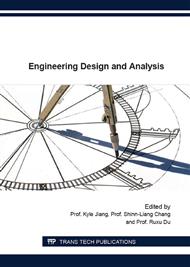[1]
Chin, K. S., Mok, C. K., & Zu, X. Modeling and performance simulation of mould-design process. The International Journal of Advanced Manufacturing Technology, 34( 3-4), 2007. 236-251.
DOI: 10.1007/s00170-006-0584-5
Google Scholar
[2]
Dungworth, David. Three and a half centuries of bottle manufacture., Industrial Archaeology Review 34. 1 (2012): 37-50.
DOI: 10.1179/0309072812z.0000000002
Google Scholar
[3]
Groover, Mikell P. Fundamentals of modern manufacturing: materials, processes, and systems. John Wiley & Sons, (2007).
Google Scholar
[4]
Jong, Wen-Ren, Po-Jung Lai, and Tai-Chih Li. Integration and application of feature recognition and mould manufacturing planning, navigating process., International Journal of Production Research 52. 20 (2014): 5945-5964.
DOI: 10.1080/00207543.2014.894259
Google Scholar
[5]
Ni, Qianfu, Wen Feng Lu, and Prasad KDV Yarlagadda. A PDM-based Framework for Design to Manufacturing in Mold Making Industry-A Case Study of Business Process Integration., Computer-Aided Design and Applications 3. 1-4 (2006): 211-220.
DOI: 10.1080/16864360.2006.10738458
Google Scholar
[6]
Radhakrishnan, P., Subramanyan, S., & Raju, VCAD CAM CIM. New Dehi: Digital Designs. (2011).
Google Scholar
[7]
Valilai, Omid F., and Mahmoud Houshmand. LAYMOD: a layered and modular platform for CAx collaboration management and supporting product data integration based on STEP standard., International conference on mechanical, industrial, and manufacturing engineering. Vol. 78. (2011).
DOI: 10.1080/0951192x.2011.646308
Google Scholar
[8]
Kim, B. H., Park, S. B., Lee, G. B., & Chung, S. Y Framework of Integrated System for the Innovation of. Springer. (2007). (pp.1-10). Berlin: Heidelberg.
Google Scholar
[9]
Wu, Rui-Rong, and Yu-Yun Zhang. A CAPP framework and its methodology., The International Journal of Advanced Manufacturing Technology 14. 4 (1998): 255-260.
Google Scholar
[10]
Deng, Y-M., et al. A CAD-CAE integrated injection molding design system., Engineering with Computers 18. 1 (2002): 80-92.
DOI: 10.1007/s003660200007
Google Scholar
[11]
Lee, Rong-Shean, et al. A framework of a concurrent process planning system for mold manufacturing., Computer Integrated Manufacturing Systems 11. 3 (1998): 171-190.
DOI: 10.1016/s0951-5240(98)00017-2
Google Scholar
[12]
Jones, T. J., C. Reidsema, and A. Smith. Automated Feature Recognition System for supporting conceptual engineering design., KES Journal 10. 6 (2006): 477-492.
DOI: 10.3233/kes-2006-10606
Google Scholar
[13]
Hlavac, J. The Technology of Glass and Ceramics. Elsevier Scientific Publishing, New York, (1983).
Google Scholar
[14]
Groover, Mikell P. Fundamentals of modern manufacturing: materials, processes, and systems. John Wiley & Sons, (2010).
Google Scholar
[15]
Yusof, Yusri, and Keith Case. Design of a STEP compliant system for turning operations., Robotics and Computer-Integrated Manufacturing 26. 6 (2010): 753-758.
DOI: 10.1016/j.rcim.2010.05.002
Google Scholar
[16]
Bloor, M. S. STEP STandard for the Exchange of Product Model Data. Vieweg+Teubner Verlag. (2000).
Google Scholar
[17]
Arivazhagan, A., N. K. Mehta, and P. K. Jain. A STEP AP 203–214-based machinable volume identifier for identifying the finish-cut machinable volumes from rough-machined parts., The International Journal of Advanced Manufacturing Technology 42. 9-10 (2009).
DOI: 10.1007/s00170-008-1659-2
Google Scholar
[18]
Houshmand, Mahmoud, and Omid Fatahi Valilai. LAYMOD: a layered and modular platform for CAx product data integration based on the modular architecture of the standard for exchange of product data., International Journal of Computer Integrated Manufacturing 25. 6 (2012).
DOI: 10.1080/0951192x.2011.646308
Google Scholar
[19]
Trappey, Amy JC, and Chun Rong Chang. ISO10303-compliant computer-aided wheel-rim design system-the framework and data model., International Journal of Production Research 38. 6 (2000): 1325-1338.
DOI: 10.1080/002075400188870
Google Scholar
[20]
Barber, Sharon L., et al. Experience in Development of Translators for AP203 Edition 2 Construction History., Computer-Aided Design and Applications 7. 4 (2010): 565-578.
DOI: 10.3722/cadaps.2010.565-578
Google Scholar


